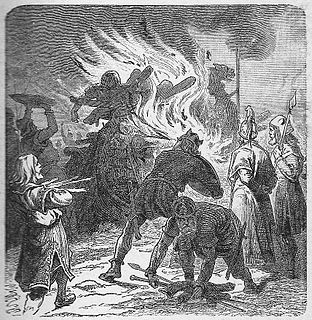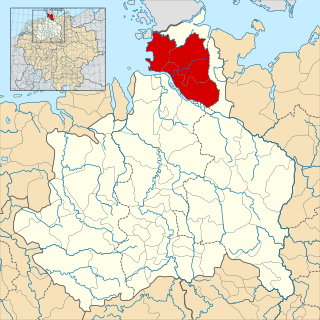
Year 814 (DCCCXIV) was a common year starting on Sunday of the Julian calendar.

Year 812 (DCCCXII) was a leap year starting on Thursday of the Julian calendar.

Ragnar Lothbrok or Lodbrok was a legendary Viking hero, as well as a legendary Danish and Swedish king. He is known from Old Norse poetry of the Viking Age, Icelandic sagas, and near-contemporary chronicles. According to the traditional literature, Ragnar distinguished himself by conducting many raids against the British Isles and the Holy Roman Empire during the 9th century. He also appears in Norse legends, and according to the legendary sagas Ragnarssona þáttr and Sögubrot af nokkrum fornkonungum, Ragnar Lodbrok's father was the legendary king of the Swedes, Sigurd Ring.

Hemming I was a king in Denmark from 810 until his death. He was the successor of King Gudfred, his uncle.

Gudfred was a ninth century Danish king who reigned from at least 804 to 810. Alternate spellings include Godfred (Danish), Göttrick (German), Gøtrik (Danish), Gudrød (Danish), and Godofredus (Latin). He stands at the threshold of the History of Denmark in the sense that he is the first ruler about whom we have substantial knowledge from contemporary sources. He waged offensive war against the Carolingian Empire with some success, but was murdered under murky circumstances before a major confrontation had taken place. There is no unambiguous trace of Gudfred in the later Norse sagas, and his history can only be traced from the hostile Frankish texts which makes an assessment of his role problematic. His paternity is unknown but he may have been closely related to Sigfred, who preceded him as king of Denmark c. 770–804. He was the uncle of the later Danish King Hemming (810–812) and the father of King Horik I (813–854).

Sigurd Ring was a legendary king of the Swedes mentioned in many old Scandinavian sagas. According to these sources he was granted rulership over Sweden as a vassal king under his uncle Harald Wartooth. Later he would take up arms against his uncle Harald in a bid to overthrow him and take the crown of Denmark, a conflict which Sigurd eventually won after the legendary Battle of the Brávellir, where it is said that Odin himself intervened and killed Harald. In the Sagas Sigurd is also known for being the father of the Norse Viking hero and legendary king of Denmark and Sweden, Ragnar Lodbrok. According to Bósa saga ok Herrauds, there was once a saga on Sigurd Ring, but this saga is now lost.
Harald 'Klak' Halfdansson was a king in Jutland around 812–814 and again from 819–827.

Sigfred was an eighth century Danish king who is known to have reigned from before 777 to after 798. Fragments of his reign can be traced via Frankish sources.

Nordalbingia was one of the four administrative regions of the medieval Duchy of Saxony, the others being Angria, Eastphalia, and Westphalia. The region's name is based on the Latin name Alba for the Elbe River and refers to an area predominantly located north of the Lower Elbe, roughly corresponding with the present-day Holstein region. Situated in what is now Northern Germany, this is the earliest known dominion of the Saxons.

Horik I or Hårik was a king of the Danes. He was co-ruler from 813, and sole king from c. 828 until his violent death in 854. His long and eventful reign was marked by Danish raids on the Carolingian Empire of Louis the Pious, son and successor of Charlemagne.

Horik II, also known as Hårik or, in late sources, Erik Barn, was King of the Danes from the fall of Horik I in 854 to an unknown date between 864 and 873. During his reign the Danish kingdom showed tendencies of breaking up. After his demise under unknown circumstances, Denmark entered a long period of obscurity, until the rise of the Jelling dynasty in the 10th century.
A Dane named Hemming was a count in the area of Rüstringen in East Frisia in the 9th century. He and some others of his family were installed in this region by Emperor Lothair I.
Halfdan was a leading person among the Danes and the first known Scandinavian to enter Frankish service. Onomastics links him to the Danish royal family since the name "Halfdan" was commonly employed both historically and in the legendary royal lineage.
Hemming Halfdansson was "of the Danish race, a most Christian leader". He was probably a son of Halfdan, a leading Dane who became a vassal of Charlemagne in 807. He was probably related to the Danish royal family, as "Hemming" was one of their favoured names. The onomastic evidence includes the Danish king Hemming I and then a Hemming II, who was recalled to Denmark from Francia by his brothers Harald Klak and Reginfrid after Hemming I's death. This Hemming was probably the same person as Hemming Halfdansson. He probably soon returned to Francia, since there is no evidence of him in Danish politics after he and his brothers were driven out by the sons of Godfrid in 813.
The Testament of Charlemagne was documented and witnessed in 811, the 43rd year of his reign. Charlemagne had intended to make a last will and testament in order to share his wealth with his daughters and the children of his concubines. Unfortunately, it was begun too late and was not finished before his death in 814. Nevertheless, three years prior, he made a division of his possessions, ratified in the presence of the faithful who were called upon as witnesses. The text of this testament is quoted from Einhard.
Helge was a Danish king who ruled at the end of the 9th century. There is no contemporary evidence for his existence, since he is only mentioned in a source from the 11th century.

Sigfred was a competitor for the Danish throne in 812. His brief appearance inaugurated a period of throne struggles in Denmark which lasted until 827.

Anulo or Ale was a pretender-king who vied for the Danish throne in 812. He represents the appearance of the House of Harald which competed with the House of Gudfred for power in Denmark until c. 857 and possibly longer.